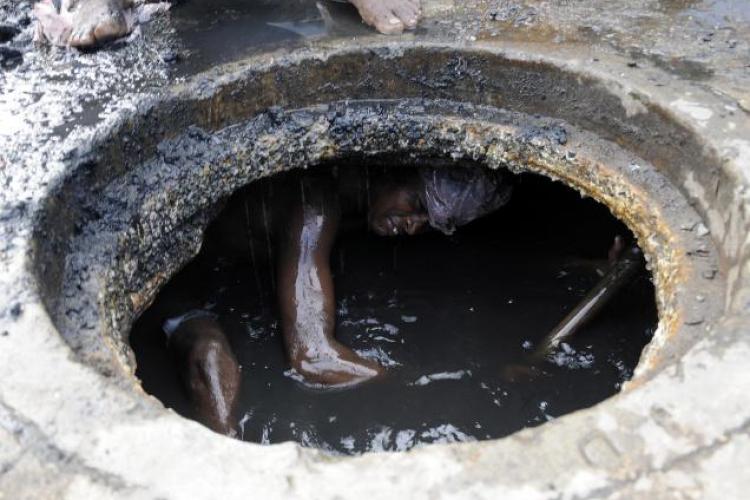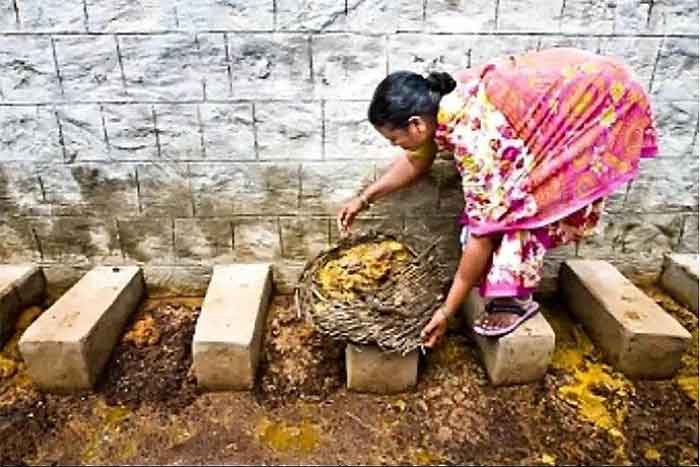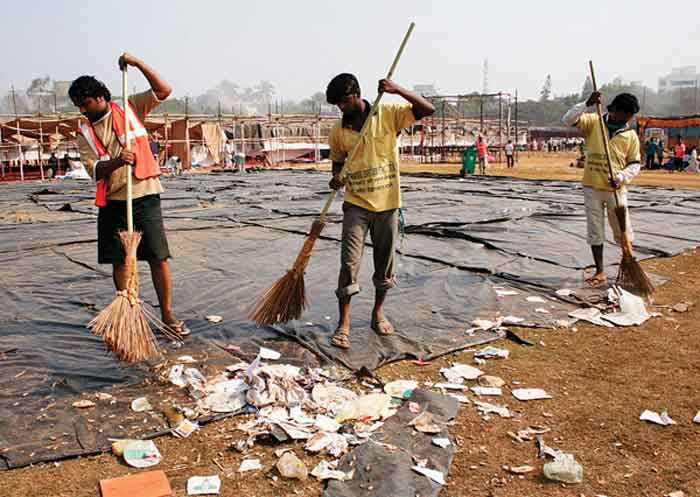Co-Written by Aseem Hasnain, Abhilasha Srivastava and Avinav Kumar

Sudharak Olwe’s photographs of conservancy workers in Mumbai are heartbreaking. They depict the lives and work of sanitation workers, as much as they reflect the fundamental nature of our society. In this haunting image a young adult is standing neck deep in an open bubbling drain, underground, both literally and metaphorically. His entire torso is buried in clogged slime, human excreta, and a variety of waste. His face is above the sewage, so he can breathe, stay alive, and continue to clean the waste, thus reassuring both the residents of the city who produce this waste, and the municipal system that ‘manages’ the waste. Drains, and sewage lines in urban India get clogged with clockwork precision. Such regular cloggings and its manual declogging by sanitation workers across India, including thousands of deaths by asphyxiation, are not inefficiencies but deliberate, everyday reminders of the nature and design of India society. Contrary to techno-managerial assessments, India’s sewage infrastructure is built on the ‘manual scavenger’ as a given. Their bodies and labor under the cesspool, below the wicker basket full of excreta, behind the wheelbarrow of waste, and on soiled tracks at railway stations have been the constant for policy makers, urban planners, and civil engineers in India. We have continued to build and maintain our sewage infrastructure with the comforting certainty that the captive labor of ‘manual scavengers’ can be deployed at will into the depths of indignity to keep the systems running.
Finally, the young man in the drain appears to almost smile at the camera, and the viewer. That smile might be many things—his grit that he needs to deal with this indignity, his acceptance of fate accompli, or an emotional bunker where he rests conserving his strength waiting to escape his hell. But above all his smile is a required part of his duty to the viewer, to us, the so called[1] upper castes, and to our executive committee, the state. It makes us believe that everything is fine, this is ok, business as usual, just a regular day of work for a unqualified person, lacking merit, who ‘deserves’ this.
This image does not just depict this sanitation worker. It is instead, a direct measurement of the difference in between him and the viewer. The viewer, us, you, is most likely sitting at a desk, dry, clean, relaxed, probably viewing it on a laptop, looking at the image from above. You are viewing it either with an aesthetic interest in photography, or with a sanitized curiosity about society, or with an intellectual project in mind. The image does not rake our conscience much. It is stark, but too common. These naked bodies, steeped in our refuse, pass our gaze so often that they don’t make us uncomfortable at all. We have mastered the art of innocence as we regularly lower them into our waste, occasionally murdering them, institutionally, impersonally, from a distance. This innocence is not natural. It has been cultivated over generations of discursive practices and careful invention of truth claims– education, qualification, IQ, merit, hard work, and so on. As we alternate between sipping our coffee and viewing this image, we silently revel in our caste privileges, ‘not even knowing’ what caste is, wallowing in the liberal myth of a caste-blind lifestyle. At the same time we are incessant that caste and its ideologies are dead, at least in the cities, and has nothing to do with us. These denials are necessary for the upper caste. They shield us from being accountable for these photographs, and for thousands of dead bodies of sanitation workers. They prevent others from accusing us of our caste privileges. We want nobody to show us the magic mirror where our achievements, both material and social, are reflected as what they truly are: power, resources and honor amassed through generations of exploitation of Dalits and Adivasis.
As we try hard to invisibilize the windfall of our birth, we want the structures of caste to work backstage keeping everything in place. Thus, we frame arranged love-marriages within one’s caste as respect for parents’ wishes; purity and pollution becomes preferences and hygiene; discrimination becomes incompetence and laziness; and casteism becomes ‘reverse discrimination. These deceptions are so deeply embedded in our vocabulary and self-image that we deny our complicity in caste violence as simply the ‘order of things.’ This is the genius of ‘Caste,’ that Isabel Wilkerson captures eloquently[2], “Caste, like grammar, becomes an invisible guide not only of how we speak but also of how we process information, the autonomic calculations that figure into a sentence without our having to think about it.” This is not to say that Caste is an invisible force in India. It is very much present in all our acts and discourses. But the ‘cunning’ of living with it lies in how we construct alibis for our innocence, and at the same time justify its purpose. Sanitation work is thus a microcosm of caste in all its import; and our responses to it truly reflect our thinking about the caste system.
Responses to Manual Scavenging
In his 1936 essay ‘The Ideal Bhangi’[3] M. K. Gandhi reveals the desire for a particular type of sanitation worker. He was envisioned as one who would ‘cleanse the body of the society,’ and who ‘protects and safeguards the health of entire community,’ without whom society cannot survive. Therefore, the Bhangi deserved the same respect as the ‘mother who washes her baby’s dirt and preserves her health.’ Gandhi rebuked ‘cast-people’, the savarna, of practicing untouchability and for ‘not giving due recognition to the status of the Bhangi,’ which he believed had caused persistent unsanitary conditions in India. Gandhi insisted that ‘to clothe the Bhangi with dignity and respect due to him is the special task and privilege of the educated class.’ But in Gandhi’s mind ‘the ideal Bhangi’ would always know their place in the overall social hierarchy such that ‘while deriving his livelihood from his occupation, he would approach it only as a sacred duty. In other words, he would not dream of amassing wealth out of it.’ Gandhi also placed the burden of training the manual scavengers on ‘caste-people.’ This essay was Gandhi’s response to Ambedkar with whom he had an ongoing feud about the working of caste in India. Gandhi believed in the benefits of the caste system and its division of labor. His only problem was the practice of untouchability, which he considered a great flaw in the structure of caste. On the other hand, Ambedkar, whose attempts to liberate Dalits from the grip of caste were thwarted by Gandhi, viewed untouchability not as a flaw but as a fundamental feature of Hindu religion. Gandhi’s view prevailed. Then, and now. Two recent events bear witness to the persistence of Gandhi’s vision.
The first event was at the Allahabad Kumbh Mela of 2019 where Prime Minister Narendra Modi washed the feet of five sanitation workers, in a nationally televised spectacle. He complemented the ritual by declaring “Safai Karmcharis” as the heroes of his pet project ‘Swachh Bharat Abhiyan’ (SBA). This was a contrasting image to all the earlier images of the SBA, where celebrities, politicians and bureaucrats, people least likely to ever clean their own toilets, got the spotlight. His popularity rose. While Gandhi just wrote about respecting the Bhangi PM Modi actually did it. Earlier, in an unpublished book Mr. Modi had already echoed Gandhi’s thoughts calling manual scavenging a ‘spiritual experience’ for the Valmiki community.[4] Within a few days of this event, sanitation workers at the Kumbh Mela had to strike work for their unpaid wages.
The second event is the publication of an open letter[5] by concerned citizens addressed to the government and fellow Indians, especially upper caste citizens. The letter proposes that sanitation workers should be treated as health workers, given their exemplary non-stop work during the Corona virus outbreak. The writers argue that sanitation is an essential service that is necessary for maintaining positive public health outcomes, which has become more critical during the pandemic, hence it is in the interest of the ‘upper caste’ and the state to act magnanimously towards sanitation workers. The letter also asks that sanitation work should not be privatized, but should be reabsorbed within the public sector, and sanitation workers should be paid a monthly salary of twenty thousand rupees per month. The letter neatly echoes Mr. Gandhi’s thoughts.
84 years since Gandhi’s vision, 70 years after Ambedkar’s institutionalization of reservations, and despite several decades of mobilization and protests by Dalit activists,[6] we are still looking for the ‘Ideal Bhangi.’ This search has now turned into an anxiety. Dalits can be made ‘Heroes,’ essential workers, public servants, and they are symbolically revered if the need be, but their status is set in stone. They are and wishfully will remain sanitation workers. The destiny of their birth, as well as their children, and their children is fixed. And no known force has been able to change it.
Invisibilizing Essential Work: The Nexus between Society, State, and Market
During the current pandemic sanitation workers, along with others, were designated essential workers. People across the political divide clapped from the safety of their socially distanced homes to recognize their contribution in the functioning of the market economy. In the open letter, referenced above, the writers combine this recognition with the notion of enlightened self-interest, as the logic of their demands. Similar recognition for essential workers has been echoed across the world, during the current as well as past pandemics. In some cases sanitation work has also been radically reformed. The British sanitation sector underwent substantive reforms during the cholera outbreak of the mid 19th century. The epidemic spreading in the working class ghettos of London frightened well-off Londoners, bringing up the need for sanitation reforms in the city. Powerful elites realized that poor sanitation in the ghettos could undermine public health for everyone, and dying workers would hinder economic progress as well. By the 1870s, British sanitation workers leveraged these threats to frame their work as any other type of work within the economy. They presented themselves as a labor constituency, were inducted within labor unions, and political parties. Their political mainstreaming translated into better wages, working conditions, and safety within an increasingly mechanized sanitation sector of the economy.[7]
These lessons made the British aware of similar pitfalls in their colonies and they made selective investments to safeguard their officers and military bases. The motivation for these investments was precisely the same enlightened self-interest that the recent open letter is appealing to. But the interesting fact is that many cities and town across India still run on the haphazard sanitation infrastructure that was laid during the colonial regime. This begs several questions- why did a country driven by technocrats and harboring global super power dreams forget its sanitation sector, not only during its socialist past, but also in its current neoliberal phase? Why did the ‘self-interest’ that transformed sanitation work and workers in the UK, fizzle out in independent India? The most powerful factor common to all of these three phases is Caste. While the ‘White Man’s Burden’ forced the British to dent caste-based discrimination, independent India comfortably transitioned first into a secular, and casteist, socialist republic, and later into a neo-liberal casteist polity. India continues to extract the labor of sanitation workers, through jajmani in the private sphere, and for low wages in the public sector.
The issue of sanitation gained political traction again during the era of liberalization where the rhetoric of development, free markets, and individual choice were presented as the cure for Indian backwardness. In neoliberalism, the market is replacing the state, and is fast becoming the sole owner of the captive labor of manual scavengers. Rather than eradicating manual scavenging, neoliberalism has pushed it into the underpaid and invisible corners of the private sector, thus further benefiting from it.[8] In contemporary India sanitation remains synonymous with manual scavenging not as an aberration, but precisely because the extractive social relations of caste work in tandem with the accumulation of capital in neoliberalism. In fact, neoliberalism thrives only by keeping this kind of essential work, on which the relations of production are predicated, out of sight.[9] Therefore, sanitation, the foundation on which civilizations are built, must remain hidden. State, society, and the market conspire to keep sanitation invisible, and sanitation workers captive for this abject work through physical violence, social sanctions, and religious ideology. But this state of disinterest and disengagement is a deliberate choice as without this forced/unpaid/underpaid labor, creation of wealth, was not a historical possibility for Savarna landlords within the caste-based mode of production or now for the Brahmanical State within the neoliberal mode of production.
Acknowledging privilege: A Case for Reparations
The recent murder of George Floyd in Minneapolis has sent ripples across the world. Bystander videos show a smug faced white police officer, hands in his pocket, with his knees on the neck of a prostrate Black man. These visuals have again exposed the nature of racial capitalism in all its ugliness,[10] and his heart wrenching cry, ‘I can’t breathe’ has become a clarion call to end racism and systemic oppression of Blacks in the USA. Floyd’s murder has triggered a churning among some white Americans as they interrogate their racial privileges. Indians, both at home and in the US, have also jumped on the bandwagon, especially on social media.[11] However, the duplicity of this solidarity is nauseating. In India, we continue to pretend deaf-blind to the cries of ‘I can’t breathe’ from sanitation workers, whom we murder with impunity every day.[12] We carry on our everyday routines as sanitation workers remain pinned under our knees. It is high time, that this knee of caste privilege is lifted, and we acknowledge, apologize and repair.
We can start by learning from others. Racial reparations have been debated in the US since 1865, when slavery was formally abolished. Reparation advocates argue that American wealth and prosperity is based on two hundred fifty years of slavery, ninety years of Jim Crow, sixty years of separate but equal, racist law enforcement, and ongoing policies designed to keep African Americans at the bottom in all spheres of life.[13] Ta-Nehisi Coates’ moving piece shows how systemic racism touches nearly every single African American. Thus, racism and its effects in the American community cannot be waved away with a simple apology, or acknowledging the guilt, which doesn’t fix centuries of harm done by the institution. Coates’ demand for reparations is not primarily about the amount or form of the reparation, instead he argues that America should seriously consider the problem and understand that the problem with slavery and racism is far greater than the country has previously admitted. Thus, for him reparations are “full acceptance of our collective biography and its consequences—is the price we must pay to see ourselves squarely.”
Scholars and activists in India have started talking about caste reparations. Aakar Patel,[14] Sanjana Pegu,[15] and recently Suraj Yengde[16] have written about it. Dr. Sukhdeo Thorat, and Dr. Amit Thorat have been leading work on caste reparations for the Lancet Commission at Harvard University.[17] However, we yet do not have any public debates on the issue. When the debate begins, we estimate it to be vicious. Most of us remember the vitriol and protests by upper caste individuals, groups, and parties during the Mandal Commission period. This time is going to be no different. However, these reasons cannot delay the task of acknowledgement, apology, and repair. We need the ‘full acceptance of collective biography and its consequences’ now. It starts with acknowledging that caste and it’s incumbent ideologies are present in each node, capillary, nook, and cranny of Indian society. Caste is not a just a demon from the past, but a shaper of the present, and the future. It is akin to the shadow monster from stranger things,[18] omnipresent, controlling their minds and yet invisible to the upper castes. It shows itself to those who are in its clutches, feeding on Dalit bodies and souls, and reveals itself only when the portal opens. The current pandemic is one such portal[19] which has revealed the monster not only as an unequal oppressive system but also as hidden Brahmanical anxieties about the breaches that might destabilize the system. These anxieties are apparent in Gandhi’s Vision, the Prime Ministers’s symbolic feet washing, in the open letter appealing for paying better wages to sanitation workers.
The current moment is also an opportunity for upper caste Indians to acknowledge the fundamental structure of our social fabric. We must accept our collective past, present, and its consequences. Yes, sanitation workers should be treated like health workers. Yes, the sanitation sector should be ridden of its precarity. Yes, the sector should be made safe, well paying, and valuable. But this will not happen because upper caste Indians are becoming benevolent, or because the state will jettison its neoliberal spirit. It must happen because Indian civilization, as we know it, has bloomed by continuously subjugating a section of people through slavery, oppression, and social, economic and political exclusion not just in the past but till date.
Notes
[1] We use ‘upper caste’ not as an agreement with this notion, but as a popularly used marker of savarna caste identity and privileges. The same stands for the use of ‘low’ or ‘lower caste.’ These terms are unacceptable, and reflect at best how people perceive the self and other in the grand narrative of Caste.
[2] https://time.com/5870485/isabel-wilkerson-caste/
[3]http://www.columbia.edu/itc/mealac/pritchett/00ambedkar/timeline/graphics/txt_gandhi_1936_bhangis.pdf
[4] https://timesofindia.indiatimes.com/india/live-updates-save-the-constitution-campaign-by-rahul-gandhi/in-his-book-karmayog-pm-modi-justifies-manual-scavenging-by-calling-it-a-spiritual-experience-for-the-valmiki-community-this-speaks-volumes-about-his-anti-dalit-mindset/articleshow/63878162.cms
[5] https://www.newsclick.in/Sanitationa-Workers-Should-be-Identified-as-Health-Workers-COVID-19
[6] Among countless others, we especially refer to the courageous and brilliant work done by Martin Macwan (Navsarjan Trust) and Bezwada Wilson (Safai Karmachari Andola
[7] Chaplin, Susan E. 1999. “Cities, sewers and poverty: India’s politics of sanitation”. Environment and Urbanization.
[8] Harriss-White, B. (2017), “Formality and informality in an Indian urban waste economy”, International Journal of Sociology and Social Policy, Vol. 37 No. 7/8, pp. 417-434. https://doi.org/10.1108/IJSSP-07-2016-0084
[9] https://urpe.org/2020/04/02/social-reproduction-theory-and-why-we-need-it-to-make-sense-of-the-corona-virus-crisis/
[10] https://www.wbur.org/hereandnow/2020/06/19/angela-davis-protests-anti-racism
[11] https://caravanmagazine.in/essay/race-caste-and-what-it-will-take-to-make-dalit-lives-matter
[12] https://www.washingtonpost.com/world/asia_pacific/i-cant-breathe-in-sewage-worker-deaths-a-new-india-confronts-an-old-scourge/2018/09/15/3db69714-b5e3-11e8-ae4f-2c1439c96d79_story.html
[13] https://www.theatlantic.com/magazine/archive/2014/06/the-case-for-reparations/361631/
[14] https://www.livemint.com/Leisure/cJKSz0TGiLu4qGxZ50oGmJ/Make-reparations-to-Dalits-and-Adivasis.html
[15] https://feminisminindia.com/2019/04/03/caste-based-reparation-policy/
[16] https://indianexpress.com/article/opinion/columns/india-dalits-reservation-representation-suraj-yengde-6523483/
[17] https://projects.iq.harvard.edu/lancet-reparations/people/amit-thorat
[18] https://www.goodhousekeeping.com/life/entertainment/a28249315/what-is-mind-flayer-stranger-things/
[19] https://www.ft.com/content/10d8f5e8-74eb-11ea-95fe-fcd274e920ca
Co-Authors
Aseem Hasnain is Assistant Professor of Sociology at Bridgewater State University, MA, USA, and is interested in race-caste, capitalism, social movements, globalization, and the environment.
Abhilasha Srivastava is Assistant Professor of Economics at California State University, San Bernardino, CA, USA, and is interested in labor, race, caste, and capitalism.
Avinav Kumar is Head of Programmes at Phia Foundation, India, and is interested in the intersection of identities and development. He works closely with rights-based community organizations in the fields of capacity building, and institutional development.
Photo by Sudharak Olwe / https://sudharakolwe.com/insearch.html
SIGN UP FOR COUNTERCURRENTS DAILY NEWSLETTER















































